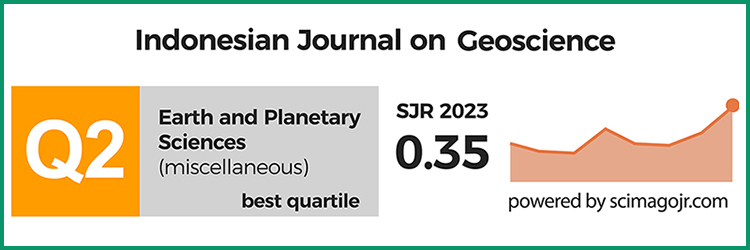Geotectonic Configuration of Kulon Progo Area, Yogyakarta
DOI:
https://doi.org/10.17014/ijog.8.4.185-190Keywords:
oblong dome, undation theory, regional tectonic pattern, mountain building, Kulon ProgoAbstract
Kulon Progo Mountain, located west of Yogyakarta, is known as a unique morphological expression of an elongated dome frequently called “oblong dome”. The structural elements occurring in Kulon Progo Mountain were predominated by a radial pattern. Applying a quantitative method to measure various morphometric elements however, revealed that the regional geotectonic pattern apparently controlled the development of Kulon Progo Mountain. A general picture of the tectonics showed that the mountain building of Kulon Progo was not solely predominated by a vertical undation force; instead it was closely related to the general geotectonics operating in the area. The macro morphological analysis using various types of satellite imageries augmented with field visits unraveled three regional tectonic stages controlled the development of Kulon Progo Mountain. Those are Meratus, Sunda, and Java trends, operating in SW-NE, NNW-SSE, and E-W directions respectively.
References
Asikin, S. 1974. Geological Evolution of Central Java and its Vicinity Viewed from the New Global Tectonic Concept. Bandung, Institute of Technology Bandung.
Haarmann, E. 1930. Die Oszillationstheorie eine Erklarung der Krustenbewegungen von Erde und Mond. Stuttgart, F. Enke.
Pulunggono, A. and Martodjojo, S. 1994. The Tectonic Changes During Paleogene-Neogene was the Most Important Tectonic Phenomenon in Java Island. Proceedings of the Seminar on Geology and Tectonics of Java Island, from the Late Mesozoic to Quaternary, Yogyakarta, Gajah Mada University, p.1-14.
Rahardjo, W., Sukandarumidi, and Rosidi, H.M.D., 1995. Geological Map of The Yogyakarta Sheet, Jawa, scale 1:100.000. Geological Research and Development Centre, Bandung.
Satyana, A. H. and Purwaningsih, M. E. M., 2002. The Basin in Central Java: A Lateral Faulting Segmentations. Geological Resources of Yogyakarta Area, Association of Indonesian Geologists - National Development University “Veteran”, Yogyakarta, p.44-56.
Soeria-Atmadja, R., Suparka, S., Abdullah, C., Noeradi, D., and Sutanto, 1998. Magmatism in Western Indonesia, the Trapping of the Sunda Block and the Gateways to the East of Sundaland. Journal of Asian Earth Sciences. 16 (1), p.1-12. doi:10.1016/S0743-9547(97)00050-0
Untung, M. and Wiriosudarmo, G., 1975. The Structural Pattern of Java and Madura based on the Preliminary Interpretation of the Gravity, Technical Publication. Geophysical Series, 2 (1), Geological Survey of Indonesia.
Van Bemmelen, R. W., 1949. The Geology of Indonesia, IA, The Hague, Martinus Nijhoff, 732pp.
Widiyanto, B.S., 2013. Anomali Gayaberat, Kegempaan Serta Kelurusan Struktur Geologi Daerah Yogyakarta dan Sekitarnya. (in prep).



















